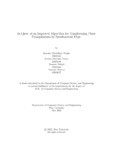| dc.contributor.advisor | Kaykobad, Mohammad | |
| dc.contributor.advisor | Kaykobad, M Tanvir | |
| dc.contributor.author | Prapty, Annesha Chowdhury | |
| dc.contributor.author | Pranty, Namira Mustafiz | |
| dc.contributor.author | Ahmed, Tasnova | |
| dc.contributor.author | Mehnaz, Tasnuba | |
| dc.date.accessioned | 2023-04-30T08:07:46Z | |
| dc.date.available | 2023-04-30T08:07:46Z | |
| dc.date.copyright | 2022 | |
| dc.date.issued | 2022-05 | |
| dc.identifier.other | ID 19101453 | |
| dc.identifier.other | ID 19101449 | |
| dc.identifier.other | ID 19101462 | |
| dc.identifier.other | ID 19101627 | |
| dc.identifier.uri | http://hdl.handle.net/10361/18198 | |
| dc.description | This thesis is submitted in partial fulfillment of the requirements for the degree of Bachelor of Science in Computer Science, 2022. | en_US |
| dc.description | Cataloged from PDF version of thesis. | |
| dc.description | Includes bibliographical references (pages 44-45). | |
| dc.description.abstract | In this thesis we have studied the problem of transforming one plane triangulation into another
by simultaneous flips of diagonals. A triangulation is a simple planar graph consisting of only
3-cycle (triangles) faces including outerface. In a triangulation, every edge lies on two faces
that form a quadrilateral. An edge flipping is an operation that replaces this edge which is
a diagonal of its corresponding quadrilateral with the other diagonal of the quadrilateral. A
simultaneous flip set is an edge set of a triangulation that when flipped, the resulting graph is
still a triangulation. Initially, it was proved that any two triangulations of equal order (number
of vertices of a graph) can be transformed from one to another using a finite sequence of edge
flip operations. Later on, it was observed that to complete this transformation, O(n log n)
individual flips are enough. In the continuation of the research, an algorithm was established
which states that the transformation can be done in 327.1 log(n) simultaneous flips. Lately, two
algorithms were introduced to improve the leading coefficient of this bound for transforming any
plane triangulation into another. These two algorithms lower this bound down to 85.8 log(n)
and 45.6 log(n) respectively. In this thesis, we have developed an algorithm to introduce two
dominant vertices simultaneously. Using our algorithm, any pair of vertices of the triangulation
can be made dominant. The process requires at most 60.8 log(n) simultaneous flips. | en_US |
| dc.description.statementofresponsibility | Annesha Chowdhury Prapty | |
| dc.description.statementofresponsibility | Namira Mustafiz Pranty | |
| dc.description.statementofresponsibility | Tasnova Ahmed | |
| dc.description.statementofresponsibility | Tasnuba Mehnaz | |
| dc.format.extent | 45 pages | |
| dc.language.iso | en | en_US |
| dc.publisher | Brac University | en_US |
| dc.rights | Brac University theses are protected by copyright. They may be viewed from this source for any purpose, but reproduction or distribution in any format is prohibited without written permission. | |
| dc.subject | Algorithm | en_US |
| dc.subject | Plane triangulations | en_US |
| dc.subject | Simultaneous flips | en_US |
| dc.subject.lcsh | Computer algorithms | |
| dc.title | In quest of an improved algorithm for transforming plane triangulations by simultaneous flips | en_US |
| dc.type | Thesis | en_US |
| dc.contributor.department | Department of Computer Science and Engineering, Brac University | |
| dc.description.degree | B. Computer Science | |

